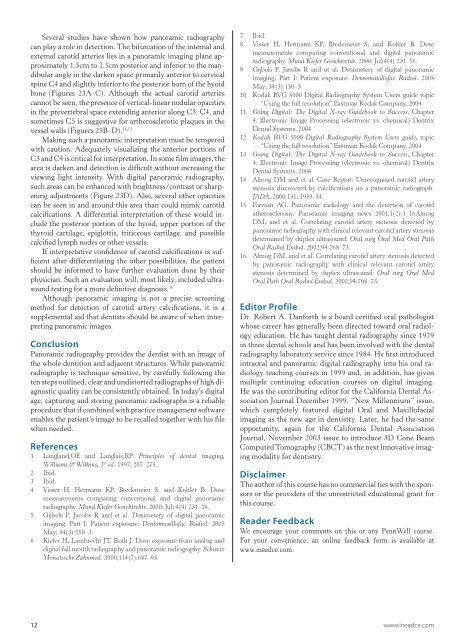Successful Panoramic Radiography - IneedCE.com
Successful Panoramic Radiography - IneedCE.com
Successful Panoramic Radiography - IneedCE.com
Create successful ePaper yourself
Turn your PDF publications into a flip-book with our unique Google optimized e-Paper software.
Several studies have shown how panoramic radiography<br />
can play a role in detection. The bifurcation of the internal and<br />
external carotid arteries lies in a panoramic imaging plane approximately<br />
1.5cm to 2.5cm posterior and inferior to the mandibular<br />
angle in the darken space primarily anterior to cervical<br />
spine C4 and slightly inferior to the posterior horn of the hyoid<br />
bone (Figures 23A–C). Although the actual carotid arteries<br />
cannot be seen, the presence of vertical-linear nodular opacities<br />
in the prevertebral space extending anterior along C3, C4, and<br />
sometimes C5 is suggestive for artherosclerotic plaques in the<br />
vessel walls (Figures 23B–D). 14,15<br />
Making such a panoramic interpretation must be tempered<br />
with caution. Adequately visualizing the anterior portions of<br />
C3 and C4 is critical for interpretation. In some film images, the<br />
area is darken and detection is difficult without increasing the<br />
viewing light intensity. With digital panoramic radiography,<br />
such areas can be enhanced with brightness/contrast or sharpening<br />
adjustments (Figure 23D). Also, several other opacities<br />
can be seen in and around this area than could mimic carotid<br />
calcifications. A differential interpretation of these would include<br />
the posterior portion of the hyoid, upper portion of the<br />
thyroid cartilage, epiglottis, triticeous cartilage, and possible<br />
calcified lymph nodes or other vessels.<br />
If interpretative confidence of carotid calcifications is sufficient<br />
after differentiating the other possibilities, the patient<br />
should be informed to have further evaluation done by their<br />
physician. Such an evaluation will, most likely, included ultrasound<br />
testing for a more definitive diagnosis. 16<br />
Although panoramic imaging is not a precise screening<br />
method for detection of carotid artery calcifications, it is a<br />
supplemental aid that dentists should be aware of when interpreting<br />
panoramic images.<br />
Conclusion<br />
<strong>Panoramic</strong> radiography provides the dentist with an image of<br />
the whole dentition and adjacent structures. While panoramic<br />
radiography is technique sensitive, by carefully following the<br />
ten steps outlined, clear and undistorted radiographs of high diagnostic<br />
quality can be consistently obtained. In today’s digital<br />
age, capturing and storing panoramic radiographs is a reliable<br />
procedure that if <strong>com</strong>bined with practice management software<br />
enables the patient’s image to be recalled together with his file<br />
when needed.<br />
References<br />
1 Langland,OE and Langlais,RP. Principles of dental imaging,<br />
Williams & Wilkins, 1 st ed. 1997; 207–275.<br />
2 Ibid.<br />
3 Ibid.<br />
4 Visser H, Hermann KP, Bredemeier S, and Kohler B. Dose<br />
measurements <strong>com</strong>paring conventional and digital panoramic<br />
radiography. Mund Kiefer Gesichtschir. 2000: Jul; 4(4) 231–16.<br />
5 Gijbels F, Jacobs R and et al. Dosimetery of digital panoramic<br />
imaging. Part I: Patient exposure. Dentomaxillofac Radiol. 2005<br />
May; 34(3):150–3.<br />
6 Kiefer H, Lambrecht JT, Roth J. Dose exposure from analog and<br />
digital full mouth radiography and panoramic radiography. Schweiz<br />
Monatsschr Zahnmed. 2000;114(7):687–93.<br />
7 Ibid.<br />
8 Visser H, Hermann KP, Bredemeier S, and Kohler B. Dose<br />
measurements <strong>com</strong>paring conventional and digital panoramic<br />
radiography. Mund Kiefer Gesichtschir. 2000: Jul;4(4) 231–16.<br />
9 Gijbels F, Jacobs R and et al. Dosimetery of digital panoramic<br />
imaging. Part I: Patient exposure. Dentomaxillofac Radiol. 2005<br />
May; 34(3):150–3.<br />
10 Kodak RVG 5000 Digital <strong>Radiography</strong> System Users guide topic<br />
— “Using the full resolution” Eastman Kodak Company, 2004<br />
11 Going Digital: The Digital X-ray Guidebook to Success, Chapter<br />
4: Electronic Image Processing (electronic vs. chemical) Dentrix<br />
Dental Systems, 2004<br />
12 Kodak RVG 5000 Digital <strong>Radiography</strong> System Users guide, topic<br />
— “Using the full resolution” Eastman Kodak Company, 2004<br />
13 Going Digital: The Digital X-ray Guidebook to Success, Chapter<br />
4: Electronic Image Processing (electronic vs. chemical) Dentrix<br />
Dental Systems, 2004<br />
14 Almog DM and et al. Case Report: Unrecognized carotid artery<br />
stenosis discovered by calcifications on a panoramic radiograph.<br />
JADA, 2000;131: 1953–54.<br />
15 Farman AG. <strong>Panoramic</strong> radiology and the detection of carotid<br />
atherosclerosis. <strong>Panoramic</strong> imaging news 2001;1(2):1–16Almog<br />
DM, and et al. Correlating carotid artery stenosis detected by<br />
panoramic radiography with clinical relevant carotid artery stenosis<br />
determined by duplex ultrasound. Oral surg Oral Med Oral Path<br />
Oral Radiol Endod. 2002;94:768–73.<br />
16 Almog DM, and et al. Correlating carotid artery stenosis detected<br />
by panoramic radiography with clinical relevant carotid artery<br />
stenosis determined by duplex ultrasound. Oral surg Oral Med<br />
Oral Path Oral Radiol Endod. 2002;94:768–73.<br />
Editor Profile<br />
Dr. Robert A. Danforth is a board certified oral pathologist<br />
whose career has generally been directed toward oral radiology<br />
education. He has taught dental radiography since 1979<br />
in three dental schools and has been involved with the dental<br />
radiography laboratory service since 1984. He first introduced<br />
intraoral and panoramic digital radiography into his oral radiology<br />
teaching courses in 1999 and, in addition, has given<br />
multiple continuing education courses on digital imaging.<br />
He was the contributing editor for the California Dental Association<br />
Journal December 1999. “New Millennium” issue,<br />
which <strong>com</strong>pletely featured digital Oral and Maxillofacial<br />
imaging as the new age in dentistry. Later, he had the same<br />
opportunity, again for the California Dental Association<br />
Journal, November 2003 issue to introduce 3D Cone Beam<br />
Computed Tomography (CBCT) as the next innovative imaging<br />
modality for dentistry.<br />
Disclaimer<br />
The author of this course has no <strong>com</strong>mercial ties with the sponsors<br />
or the providers of the unrestricted educational grant for<br />
this course.<br />
Reader Feedback<br />
We encourage your <strong>com</strong>ments on this or any PennWell course.<br />
For your convenience, an online feedback form is available at<br />
www.ineedce.<strong>com</strong>.<br />
12 www.ineedce.<strong>com</strong>

















